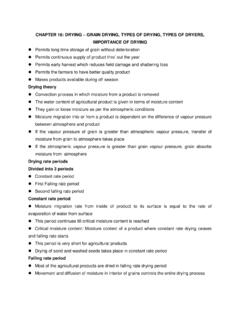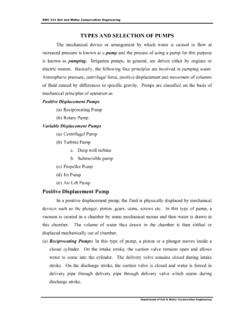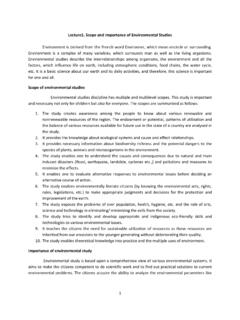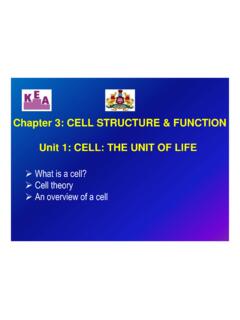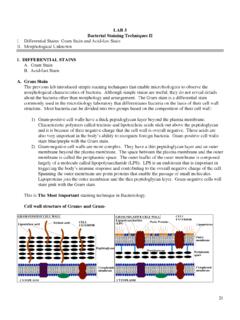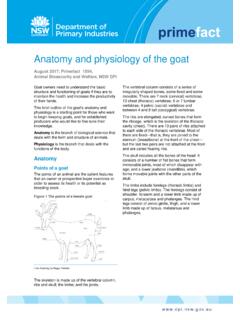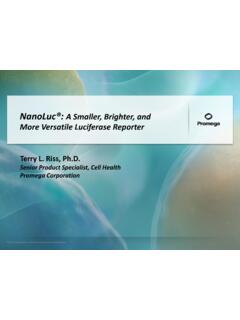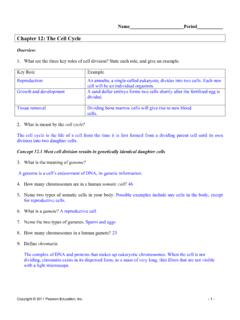Transcription of RNA AND ITS STRUCTURE, FUNCTION AND TYPES
1 rna and its structure , FUNCTION AND TYPES With the discovery of the molecular structure of the DNA double helix in 1953, researchers turned to the structure of ribonucleic acid (RNA) as the next critical puzzle to be solved on the road to understanding the molecular basis of life. Ribonucleic acid (RNA) is a type of molecule that consists of a long chain of nucleotide units. Each nucleotide consists of a nitrogenous base, a ribose sugar, and a phosphate. RNA is very similar to DNA, but differs in a few important structural details: in the cell, RNA is usually single-stranded, while DNA is usually double-stranded; RNA nucleotides contain ribose while DNA contains deoxyribose (a type of ribose that lacks one oxygen atom); and RNA has the base uracil rather than thymine that is present in DNA.
2 RNA is transcribed from DNA by enzymes called RNA polymerases and is generally further processed by other enzymes. RNA is central to the synthesis of proteins. Here, a type of RNA called messenger RNA carries information from DNA to structures called ribosomes. These ribosomes are made from proteins and ribosomal RNAs, which come together to form a molecular machine that can read messenger RNAs and translate the information they carry into proteins. There are many RNAs with other roles in particular regulating which genes are expressed, but also as the genomes of most viruses.
3 Ribose Nucleic Acids Most cellular RNA is single stranded, although some viruses have double stranded RNA. The single RNA strand is folded upon itself, either entirely or in certain regions. In the folded region a majority of the bases are complementary and are joined by hydrogen bonds. This helps in the stability of the molecule. In the unfolded region the bases have no complements. Because of this RNA does not have the purine, pyrimidine equality that is found in DNA. RNA also differs from DNA in having ribose as the sugar instead of deoxyribose.
4 The common nitrogenous bases of RNA are adenine, guanine, cytosine and uracil. Thus the pyrimidine uracil substitutes thymine of DNA. In regions where purine pyrimidine pairing takes place, adenine pairs with uracil and guanine with cytosine. In addition to the four bases mentioned above, RNA also has some unusual bases. CHEMICAL structure OF RNA An important structural feature of RNA that distinguishes it from DNA is the presence of a hydroxyl group at the 2' position of the ribose sugar. The presence of this functional group causes the helix to adopt the A-form geometry rather than the B-form most commonly observed in DNA.
5 This results in a very deep and narrow major groove and a shallow and wide minor groove. A second consequence of the presence of the 2'-hydroxyl group is that in conformationally flexible regions of an RNA molecule (that is, not involved in formation of a double helix), it can chemically attack the adjacent phosphodiester bond to cleave the backbone. Most cellular RNA molecules are single stranded. They may form secondary structures such as stem-loop and hairpin. Secondary structure of RNA. (a) stem-loop. (b) hairpin. There are more unusual bases in RNA than in DNA.
6 All normal RNA chains either start with adenine or guanine: Three TYPES of cellular RNA have been distinguished: Messenger RNA (mRNA) or template RNA Ribosomal RNA (rRNA) and Soluble RNA (sRNA) or transfer RNA (tRNA) Ribosomal and transfer RNA comprise about 98% of all RNA. All three forms of RNA are made on a DNA template. Transfer RNA and messenger RNA are synthesized on DNA templates of the chromosomes, while ribosomal RNA is derived from nucleolar DNA. The three TYPES of RNA are synthesized during different stages in early development.
7 Most of the RNA synthesized during cleavage is mRNA. Synthesis of tRNA occurs at the end or cleavage, and rRNA synthesis begins during gastrulation. Comparison between DNA and RNA DNA RNA 1. DNA is the usual genetic material RNA is the genetic material of some viruses. 2. DNA is usually double-stranded, (In certain viruses DNA is single stranded, X 174). Most cellular RNA is single stranded. (Some viruses retrovirus, have double stranded RNA). 3. The pentose sugar is deoxyribose. The pentose sugar is ribose. 4. The common organic bases are adenine, guanine, cytosine and thymine.
8 The common organic bases are adenine, guanine, cytosine and uracil. 5. Base pairing: adenine pairs with thymine and guanine with cytosine. Adenine pairs with uracil and guanine with cytosine. 6. Pairing of bases is throughout the length of the molecule. Pairing of bases is only in the helical region 7. There are fewer uncommon bases There are more uncommon bases. 8. DNA is only of one type There are three TYPES of RNA messenger, ribosomal and transfer RNA. 9. Most of the DNA is found in the chromosomes. Some DNA is also found in the cytoplasm in mitochondria and chloroplasts.
9 Messenger RNA is formed on the chromosomes, and is found in the nucleolus and cytoplasm. rRNA and tRNA are also formed on the chromosomes, and are found in cytoplasm. 10. Denaturation (melting) is partially reversible only under certain conditions of slow cooling (renaturation). Complete and practically in stantaneous reversibility of the process of melting. 11. Sharp, narrow temperature interval of transition in melting. Broad temperature interval of transition in melting. 12. DNA on replication forms DNA, and on transcription forms RNA. Usually RNA does not replicate or transcribe.
10 (In certain viruses RNA can synthesize an RNA chain). 13. Genetic messages are usually encoded in DNA. The usual FUNCTION of RNA is translating messages encoded in DNA into proteins. 14. DNA consists of a large number of nucleotides, up to million RNA consists of fewer nucleotides, up to 12,000. Ribosomal RNA rRNA Ribosomal RNA, as the name suggests, is found in the ribosomes. It comprises about 80% of the total RNA of the cell. The base sequence of rRNA is complementary to that of the region of DNA where it is synthesized. In eukaryotes ribosomes are formed on the nucleolus.


